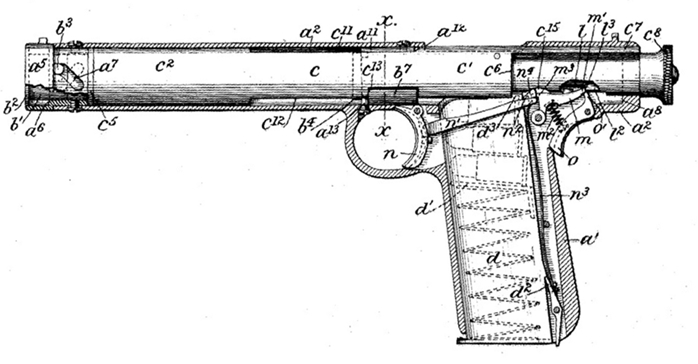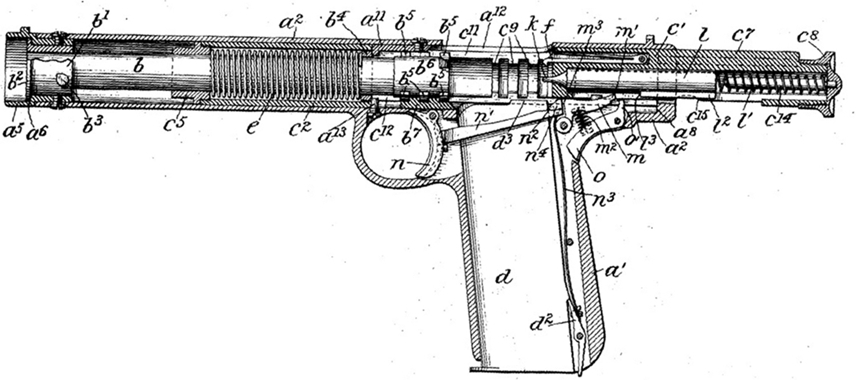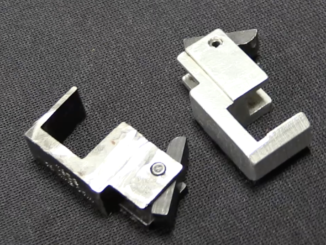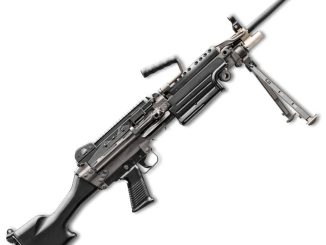In 1897, John M. Browning was awarded four consecutive patents, which covered a big swath of possible automatic pistol designs. The one we’re looking at today (pointed out to me by Rufus at SHOT – thanks!) is number 580,925, which pertains to a rotating-barrel lockup system. Yep, Browning patented that 15 years before the rotating-barrel Steyr went into production. It never went into production, but is definitely worth a look anyway.
Browning’s rotary design, unlike some of his other early pistols, has nice lines to it:

Unlike the Steyr 1912, this pistol did not use a modern-style slide. Instead, the shroud around the barrel was an integral part of the frame. It used a separate tubular slide assembly inside the shroud to affect rotation, with the barrel, equivalent in function to the slide on the Steyr. This inner tube (bolt carrier, really) held the locking lugs It used a pair of cams at the muzzle (A7 & B3) to control barrel rotation. The barrel and bolt carrier would stay locked together for the first bit of rearward motion (the precise distance required would have been determined through experimentation), and then the cammed grooves in the carrier would start to turn, unlocking it from the barrel.

The other features of the design were typical Browning – striker type firing pin, trigger wrapping around the magazine, grip safety, and even locking lugs that would blend right to other Browning designs. As a side note, it’s interesting to note that the design has no manual safety, just the grip safety. So why didn’t this go into production? I’m not sure – I don’t see any glaring problems, but I’m not an expert gunsmith by any stretch. My guess would be that Browning’s work with FN on the Model 1900 took up enough time that he just couldn’t pursue everything he had thought up.
It would make a neat project for someone with some spare time and CNC tools though, wouldn’t it?
You can download the complete patent here:
US Patent 580,925 (John M Browning, “Firearm”, April 20, 1897)




It is interesting to note that the grip safety on the Browning 1897 is gravity-assisted. Given that a 1911-style grip-safety is liable to cause issues like this one:
http://www.ar15.com/forums/t_1_5/988015_My_CCW_Shooting_AAR__Now_with_Moar_Graphic_Pics_on_pg_29_and_30.html
it is likely that the reason Browning did not incorporate this gravity-assisted safety in later weapons is that the company that held the patent sat on it.
Indeed, many features of the Browning 1897 are desirable over his later designs, suck as the much lower bore axis.
seems like it would be a natural to be silenced. reminds me of the Welrod.
Some credit where credit is due; Max Popenker is the one who initially referred me to this patent.
I did a bit of further research, and one of the stories I’ve found holds that Colt bought this and a whole mess of other Browning patents and never produced the designs described therein. It would appear that their strategy was simply to deny other companies those patents, never to actually produce anything based on them. Not sure if that’s the whole story, but it would explain why this pistol was never produced.
Browning’s standard procedure was to sell the patent rights for his pistol designs to both Colt (for the American market) and FN (for the European market), and they’d choose which ones they wanted to put into production. While they usually didn’t pick the same patents to work with (the FN 1905/Colt 1908 vest pocket being the exception), FN was also planning to market a variation of the Browning’s 1910 patent (better known as the Colt M1911) in the Balkans. But World War I put a stop to that.